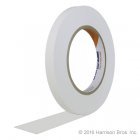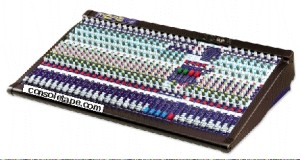
People who create temporary labels for sound consoles focus, rightly so, on “the horizontal”. By that, I mean that the primary purpose of the label is to indicate what microphone is represented by each input on the mixing desk. Normally the labels go directly under the mix fader and include information like “vocal”, “bass”, “kick drum”, etc.
Since most mixers are a long row of identical control strips, the labels make sure that the tech doing the mixing is moving the correct fader to make the changes they want.
The use of half-inch wide console tape allows you to expand this labeling to mark additional information about every control knob for each individual console input. Using tape that will fit between the fader strips means that you can also make notes and marks about equalization, aux sends, monitor mixes etc. It dramatically improves your ability to retain detailed information when you have dialed in a mix that you need to recreate later.
Add a roll of half-inch label tape and a fine point Sharpie to your tool kit if you regularly find yourself sharing a console with other acts. It’s essential during festival season.









